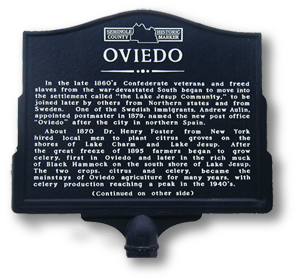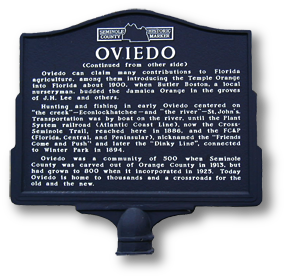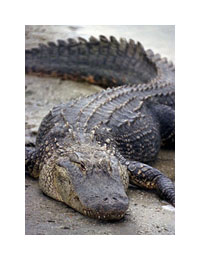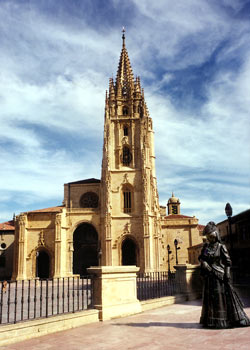
Oviedo, Florida

|
|
In the late 1860's Confederate veterans and freed slaves from the war devastated South began to move into the settlement called "the Lake Jesup Community", to be joined later by others from the Northern states and from Sweden. One of the Swedish immigrants, Andrew Aulin, appointed postmaster in 1879, named the new post office "Oviedo" after the city in northern Spain.
About 1870 Dr. Henry Foster from New York hired local men to plant citrus groves on the shores of Lake Charm and Lake Jesup. After the great freeze of 1895 farmers began to grow celery, first in Oviedo and later in the rich muck of Black Hammock on the south shore of Lake Jessup. The two crops, citrus and celery, became the mainstays of Oviedo agriculture for many years, with celery production reaching a peak in the 1940's. |
| Oviedo Historic Marker (front) |
|
|
Oviedo can claim many contributions to Florida agriculture, among them introducing the Temple Orange into Florida about 1900, when Butler Boston, a local nurseryman, budded the Jamaican Orange in the groves of J. H. Lee and others.
Hunting and fishing in early Oviedo centered on "the creek" - Econlockhatchee - and "the river" - St. John's. Transportation was by boat on the river, until the Plant System railroad (Atlantic Coast Line), now the Cross-Seminole Trail, reached here in 1886, and the FC&P (Florida, Central, and Peninsular), nicknamed the "Friends Come and Push" and later the "Dinky Line", connected to Winter Park in 1894.
Oviedo was a community of 500 when Seminole County was carved out of Orange County in 1913, but had grown to 800 when it incorporated in 1925. Today Oviedo is home to thousands and a crossroads for the old and the new. |
|

|
| Oviedo Historic Marker (back) |
|
Formally incorporated as a City in 1925 with a population of 800, Oviedo has roots that date back to just after the Civil War in 1865 when homesteaders came to the area along the shores of Lake Jesup to begin new lives. Prior to the arrival of these adventurous souls, including former slaves, and immigrants from Europe, primarily Sweden, the area that is now Oviedo was populated by the Timucua, a clan of native Americans who were a part of the Seminole tribe. No evidence of the early Timucuan settlements remains today; their hunting grounds and villages disappeared just prior to the establishment of the Lake Jesup Community, which decades later gave way to modern housing developments, shopping centers, parks, recreation facilities, conservation areas and interstate roadways that can take travelers across the state.
Early settlers to the area relished the fertile land. They grew crops of celery and citrus and traveled to Orlando and Sanford to sell their produce. Orlando was reached via a wagon-wheel rutted road, but the primary means of travel from the area were steam ships like the Volusia or the Hattie Baker and small boats, which docked at Solary’s Wharf and Mitchell dock. Mail arrived in the area via riverboat twice a week and soon a post office was established. Andrew Aulin, a Swedish immigrant who spoke four languages and loved to read, was appointed postmaster. He was asked to name the new post office. On March 13, 1879 the name Lake Jesup Community faded into history as Aulin chose the name Oviedo, pronounced O-vee-a-dough in those days, to be the name of the post office and soon the surrounding town. Aulin liked the idea of giving the post office a Spanish name to go along with the Spanish heritage of the state of Florida. The original Oviedo is a city in northern Spain established in the 8th century and known for its architecture, a magnificent ancient cathedral and its dedication to higher education through the University of Oviedo. Today we pronounce Oviedo differently, O-vee-dough, but the City’s link to Oviedo, Spain still exists. The two cities have established an informal sister city relationship that promises to be mutually beneficial to both communities.
Oviedo in 2007 only vaguely resembles Oviedo of 1925. Citrus and celery are no longer produced here in large quantities, but are still found in many backyard gardens.
Lake Jessup
Experience the thrill of an airboat ride on beautiful Lake Jessup in Oviedo, Florida. Situated in a beautiful rural setting on Lake Jessup. Ten thousand acres large and over 100,000 years old, Lake Jessup. In the heart of Seminole County along the middle basin of the St. Johns River, Lake Jesup encompasses an area of approximately 16,000 acres, including open water and floodplain.
It is home to some of Florida's most unique wildlife. See beautiful foliage, alligators, eagles, osprey, and many types of wildlife in their natural habitat. Lake Jessup is anthropologically rich and has been researched by at least 3 major universities. Don't forget your camera, Lake Jessup has the highest population of alligators of any lake in Florida. Over the years, bald eagles, manatees, ibises, wood storks and sandhill cranes have made Lake Jesup their home.
Once a thriving water body, attracting thousands of recreational boaters and anglers to the area, Lake Jesup has slowly degraded since the 1960s as Central Florida has grown up around it. Decades of wastewater effluent discharges directly into the lake, stormwater discharges from surrounding tributaries, the construction of berms that segregated the lake from parts of its floodplain and a causeway that reduced the lake's connection with the St. Johns River have all taken a significant toll on the sensitive ecosystem.
Events in the late 1980s highlighted the need for focus on growths' negative impact on Lake Jesup. The planned construction of State Road 417 across the lake and its floodplain spurred the organization of the 'Lake Jesup Restoration Task Force' which hoped to deal with the impacts of that project and the many environmental needs of the lake. This task force struggled and ultimately disbanded in 1993, frustrated by the inability to synchronize the efforts of the many government agencies that would be needed to effectively address the problems of the lake. This frustration was shared by all of the citizens' groups who had for so long tried to get something positive done for the lake.
That continued struggle led to the formation of a group of 16 state agencies and environmental and homeowners organizations from throughout central Florida to find solutions to the lake’s problems. With support from citizen groups in the Lake Jesup vicinity, Florida Rep. Marvin Couch of Oviedo sponsored a bill in the 1994 Florida legislative session that created the Friends of Lake Jesup Restoration and Basin Management Team, designated the group’s membership, and directed its responsibilities. The bill also established the District as the lead agency of the restoration effort, and directed that it provide the necessary technical support.
Restoring Lake Jesup, which is fed primarily by creeks with some minimal discharge from Clifton Springs, is not only important to the central Florida community, but also to the St. Johns River system. The St. Johns River flows north for 310 miles from Indian River County to the Atlantic Ocean at Jacksonville. Lake Jesup’s waters join that system just north of the State Road 46 bridge between lakes Monroe and Harney, both straddling the border between Seminole and Volusia counties. |
Oviedo Traditions
OviedoTraditions.org, is a community resource brought to you by The Oviedo Preservation Project (TOPP), and TOPP is a cooperative effort that draws its participants from a variety of already-existing groups, including The Oviedo Historical Society, Old Downtown Development Group, Oviedo CANDOR, and more. Despite a diversity of opinion on just where Oviedo should be headed, everyone involved with the project believes that preserving Oviedo's hometown feel is a priority.
TOPP does not seek to further any particular course of action by the government or private citizens. Rather, TOPP seeks to offer a sounding board for ideas about preservation, and to encourage city officials to make decisions only after considering the consequences of their actions on historically or culturally significant resources.
Their mission is to assist in helping Oviedo officials make well-informed decisions about preserving places, structures, and ideas that are distinctly Oviedo. To facilitate this, TOPP seeks to assist with data collection, consensus-building, and any other effort that may assist council in preserving parts of Oviedo that hold special meaning for not only our own citizens, but citizens of Seminole County, Central Florida, the State of Florida, and the entire country.
This website's goal is to give citizens in Oviedo and the surrounding communities a place to look for interesting tidbits about Oviedo, its history, and its traditions.
Source: www.oviedotraditions.org
|
Sister City information
The City of Oviedo, Florida has a sister city...Oviedo, Spain. Our City is pronounced O-vee-dough, our Spanish counterpart is pronounced O-vee-a-dough. Florida's Oviedo was incorporated in 1925. Spain's Oviedo was established in the 8th century. Visit the website of Oviedo, Florida's sister city Oviedo, Spain and learn more about the City that inspired the establishment of a City in the sunshine state.
Oviedo, Spain
Source: www.cityofoviedo.net
|
|
|
|
|
|

